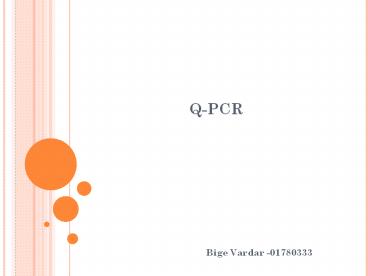Q-PCR - PowerPoint PPT Presentation
1 / 23
Title:
Q-PCR
Description:
Q-PCR Bige Vardar -01780333 OUTLINE What is PCR and purpose of it? What is Q-PCR and purpose of it? How does Q-PCR work? Types of Q-PCR probes and comparison of types ... – PowerPoint PPT presentation
Number of Views:231
Avg rating:3.0/5.0
Title: Q-PCR
1
Q-PCR
- Bige Vardar -01780333
2
OUTLINE
- What is PCR and purpose of it?
- What is Q-PCR and purpose of it?
- How does Q-PCR work?
- Types of Q-PCR probes and comparison of types
- Advantages and Disadvantages of Q-PCR vs. PCR
- Questions
3
What is PCR?
- Stands for Polymerase Chain Reaction
- copies of DNA fragment(X)Xo(1E)n where nof
cycles in PCR reaction and Eefficiency - Steps in PCR
- Denaturation(95oC)1min
- Annealing(55oC)45sec
- Extension(72oC)2min
- Cycle thorugh 25-35
4
Purpose of PCR
- Easy to sequence some of million copies and
detect rather than trying to sequence and detect
a single copy of a gene - Can calculate which sample is biggest when
comparing two or more DNA fragments - It is used to clone specific genes
5
What is Q-PCR?
- Stands for Quantitative Polymerase Chain Reaction
- Assay that monitors accumulation of DNA from a
PCR reaction - Important technique to quantify RNA(mRNA) levels
and DNA gene levels in biological samples - Templates DNA, cDNA,RNA
- Similar to PCR except the progress is monitored
by a camera or detector - Uses fluorescence-based probes to detect DNA or
RNA - Data collection start at early exponential phase
and examined at the same time with detection
6
(No Transcript)
7
Research Objectives
- Gene validation
- Primary validation
- Confirmation of microarray data
- Viral detection
- Bacterial detection and identification
- Gene duplication or DNA quantification
- www.scienceboard.net
8
Applications
- Pathogen detection
- GMO analysis
- Quality control
- Forensics
- Methylation studies
- Detect proteins with Q-PCR
- DNA/RNA quantification
- Protein stability testing
- Drug therapy efficacy / drug monitoring
9
Q-PCR
- Assay uses a standard curve to quantitate the
amount of target present using a
fluorescence-labeled probe for detection. - Each technique uses some kind of fluorescent
marker which binds to the DNA
10
Types of Q-PCR
- Hydrolyzation based Assays
- Taqman, Beacons, Scorpions
- DNA-binding agents
- SYBR Green
- Hybridization based Assay
- Light cycler(Roche)
11
Taqman Probes
- Fluorescence-labeled oligonucleotides (TaqMan
probes) - TaqMan probes are complementary to a region of
the target gene - The 5' to 3' exonuclease activity of the
polymerase cleaves the probe, releasing the
fluorophore into solution
12
Characteristics of Taqman Probes
- Oligonucleotides longer than the primers (20-30
bases long with a Tm value of 10 oC higher) that
contain a fluorescent dye usually on the 5' base,
and a quenching dye typically on the 3' base - The excited fluorescent dye transfers energy to
the nearby quenching dye molecule rather than
fluorescing(FRET) - Uses universal thermal cycling parameters and PCR
reaction conditions - One specific requirement for fluorogenic probes
is that there be no G at the 5' end
13
Molecular Beacons
- Contain fluorescent and quenching dyes at either
end but they are designed to adopt a hairpin
structure while free in solution to bring the
fluorescent dye and the quencher in close
proximity for FRET to occur - Have two arms with complementary sequences that
form a very stable hybrid or stem
14
molecular beacons
15
SYBR Green I
- A fluorogenic minor groove binding dye that
exhibits little fluorescence when in solution but
emits a strong fluorescent signal upon binding to
double-stranded DNA - Binds to the minor groove of the DNA double helix
with a higher affinity for dsDNA than for
single-stranded DNA (ssDNA) - Fluorescence is greatly enhanced (1000-fold) upon
DNA-binding making this dye a sensitive indicator
for the quantity of dsDNA
16
- http//www.youtube.com/watch?v5ZEySHfCWAUfeature
related
17
Taqman vs. SYBR Green I
- SYBR Green
- Advantages
- Relative low cost of primers.
- No fluorescent-labeled probes required.
- Disadvantages
- Less specific only primers determine
specificity. - Specific and non-specific double-stranded PCR
products generate the same fluorescence signal
upon binding SYBR Green I dye. - Not possible to multiplex multiple gene targets.
- TaqMan Probe
- Advantages
- Increased specificity
- Use when the most accurate quantitation of PCR
product accumulation is desired. - Option of detecting multiple genes in the same
well (multiplexing). - Disadvantages
- Relative high cost of labeled probe.
18
Q-PCR vs. PCR
- Some of the problems with End-Point Detection
- Poor Precision
- Low sensitivity
- Short dynamic range lt 2 logs
- Low resolution
- Non - Automated
- Size-based discrimination only
- Results are not expressed as numbers
- Ethidium bromide for staining is not very
quantitative - Post PCR processing
19
Eventually the reactions begin to slow down and
stop all together or plateau.Each tube or
reaction will plateau at a different point, due
to the different reaction kinetics for each
sample. These differences can be seen in the
plateau phase.The plateau phase is where
traditional PCR takes its measurement, also known
as end-point detection.
20
- Hard to differentiate between the 5-fold change
on the Agarose gel. Q-PCR is able detect a
two-fold change (i.e. 10 Vs. 20 copies).
21
BioRad iCycler
22
References
- Dorak MT (Ed) Real-Time PCR (Advanced Methods
Series). Oxford Taylor Francis, 2006
http//dorakmt.tripod.com/genetics/realtime.html - http//www.protocolonline.org/prot/Molecular_Biolo
gy/PCR/Real-time_PCR/index.html - SYBR Green Quantitative PCR Protocol
http//www.genetics.ucla.edu/labs/lusis/greenquant
itative.htm - Quantification using real-time PCR
technologylthttp//www.wzw.tum.de/gene-quantificati
on/klein-2002.pdfgt - Real-Time PCR (qPCR) Basics lthttp//www.primerdes
ign.co.uk/Download20material/Beginners20guide20
to20real-time20PCR.pdfgt
23
QUESTIONS?

